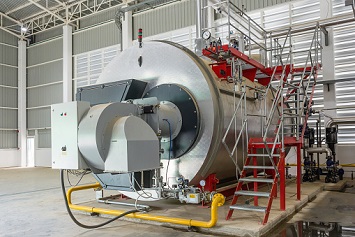An OSHA-funded presentation on boiler safety given by Western Iowa Tech Community College (WITCC) states that there are “four major categories of catastrophic failure that exist in the boiler itself.”
Specifically, these four categories are:
- Meltdown. The surface metal overheats and reaches its melting point as a result of the boiler operating at very low water conditions. Meltdown will not by itself cause an explosion but will do major damage to the boiler and create a dangerous situation that could lead to an explosion.
- Thermal shock. Low water causes the heating surfaces to become overheated. After cool water is added, the water flashes to steam that expands 1,600 times its volume. This will result in an explosion because there is not enough room for the steam to expand.
- Combustion explosions. Gases build up, and an ignition source ignites the gases. This can happen inside the boiler or outside.
- Steam pressure. Excessive steam buildup exceeds the design pressures of the vessel.
Note that the first two hazards are concerned with low water.
“Ensuring proper water level may be the most important duty of an operator,” states the WITCC. “The gauge glass is the primary device used in determining water level and must be maintained in proper condition. It is connected to the water column which levels out the turbulent water in the boiler so it can be accurately read.”
Safety Procedures
Following are several water-related safety points made in the presentation:
- The normal operating water level (NOWL) should be approximately in the middle of the gauge glass.
- All steam boilers must have two means to determine water level. The gauge glass is the first and easiest means. A second device is the try cocks, a valve located on the water column used to determine the water level if the gauge glass is not functional.
- When blowing down (intentionally wasting water) the water column and gauge glass, the operator should carefully monitor the action of the water in the gauge glass. Water should enter the gauge glass quickly when the gauge glass blowdown valve is closed, indicating that the lines are free of sludge, sediment, or scale buildup. If the water returns sluggishly to its normal level, there may be an obstruction partially blocking the flow of water. If the apparent obstruction cannot be removed by blowing down, the boiler should be shut down and allowed to cool.
- Water must be treated to remove minerals that can cause a buildup of deposits and overheating of boiler parts. Corrosion caused by the rusting or pitting of boiler metal thins and weakens the metal. Corrosion is primarily caused by oxygen in the boiler water. Oxygen and carbon dioxide in feedwater can be removed by heating. Oxygen scavenger chemicals can also be added; these combine with oxygen to form harmless compounds for removal from the boiler.
- Priming occurs when large slugs of boiler water are carried into the steam lines. Carryover occurs when small particles of boiler water are carried into the steam lines. Both conditions can be caused by a high water level in the boiler, a high concentration of chemicals in the boiler water, impurities in the boiler water that cause high surface tension (such as oil), and/or opening a main steam stop valve too quickly. These conditions can generally be addressed by increasing the blowdown rate.

